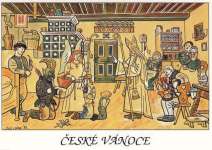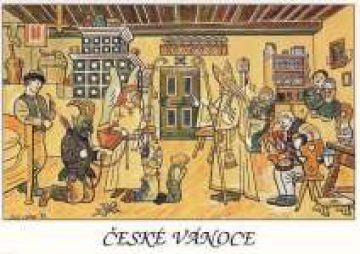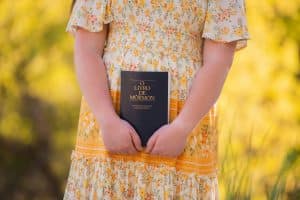 One Czech Christmas
One Czech Christmas
Wanda West Badger
Beacon Heights, Utah
Vol. 25, No. 1 (Fall 2001)
It was Friday, December 21, 1990, the shortest day of the year. Heavy snow had fallen throughout the night and an occasional flake still drifted softly from above. As we traveled, even in the gloom of an overcast German sky, we saw the beauty of the forests and small villages nestled here and there in the snowy landscape. Prominent in each town was a church steeple, and one after another these charming villages treated our eyes to true-life Christmas card scenes.
Although the Wall had come down, my husband and I were venturing into unknown territory for us—Eastern Germany and on into Prague, Czechoslovakia. We were on an errand form the Europe Area Presidency Office of the Church in Frankfurt, German, where my husband was serving as executive secretary, and our station wagon was loaded with supplies for President and Sister Winder of the Czechoslovakia Prague Mission. Because of the unusually heavy snow that year, we carried four snow tires for the Winders along with computer equipment and other special items not available in Czechoslovakia—red ribbon, Christmas lights, brownie pans, parmesan cheese, cans of tomato soup, and camera film.
Just before reaching the border and passing through the former East German village of Furth, we found that the liberation of these people, only the year before, had brought life to the town. IT was bristling with activity—people on the streets, shopping; stores with lights aglow.
We had been advised by President Winder to cross the border at Chad rather than take the shorter route through Waldthorn because the Chad crossing was supposedly faster. But at Chad, it took an hour and a half to get through the border. We first had to relinquish our passports to a stiff German guard; then patiently await the “OK” from the Czech guard. Wrapped gifts and a decorated, frosted loaf of Christmas bread, perched on top of the things we were carrying, convinced the guards that we were on a peaceful mission. Finally, we were let through the barricade and drove onto a dark, narrow, snow-packed road with one small battered road sing that directed us to “Praha.”
Leaving economically sound and brightly lit German, the starkness of Czechoslovakia pierced through us. Although it was only 6 P.M. as we drove through the villages, they seemed deserted. No cars were in sight, neither parked nor traveling the side roads. No people. No usual signs of life. Only a few dimly lit bulbs, hanging from cords, were seen burning here and there in a window. The gray buildings were shabby and worn and bordered right onto the main road that we were traveling. However, in several of the village town squares, sparse Christmas trees, some adorned with a handful of colored lights, heralded Christmas. We wondered what sacrifices had been made to put them there.
The Winders were delighted with the supplies and treats. We were thrilled to see them and to be taken on a guided walking tour of the beautiful old town, cathedrals, and gorgeous ancient buildings. We strolled across the famous Charles Bridge. We tasted Czech waffles with whipped cream and chocolate sauce. We traveled on the underground train, reaching it by a modern descending ten-story escalator. We saw stands with large tanks of carp being sold through the town, carp being the traditional main dish for Christmas dinner. The missionaries we met at the Winders’ had all been invited to members’ homes for Christmas and were hoping they wouldn’t be served carp, knowing very well that is what they would get. Truly, though, they were appreciative of whatever they were served. Food and supplies were scarce. On Sister Winder’s shopping day, only so many customers were allowed in a store at one time, so the line formed on the outside. When a shopper left the store, her car was given to the next in line. This process was repeated at the meat store, the bakery, the fruit and vegetable market, and so forth.
Tears came to our eyes when we walked through the immense Wenceslaus Square. AT the Communist takeover years before, when the Russians had driven their tanks through this beautiful place, it was said the “Prague was shamed.” Recently, when the Communists left, it was joyously stated that “Spring had gain returned to Prague.”
Driving back to our home in Germany, past the gray, colorless villages of a Czech winter—villages not so often adorned with church steeples as in Germany but rather displaying a multitude of chimneys releasing wisps of black smoke that reached for the sky—we felt a bittersweet joy. Our hearts ached when we thought of the oppression and deprivation these people had suffered for so many years.
But this Christmas they were free once again. The peace and joy of the Savior’s birth could now be celebrated openly. It was a beginning!






One Response
It’s true, Prague changed recently. I noticed it during my visit on Christmas. I noticed that the main street was fashionable, but during communism, fashionable became a moot term. I remember the street from about 15 years ago, when a large china and crystal shop stood on a corner at Old Town Square. Now the tenant is Cartier.
Elsewhere on the street are Dior, Hermes, Prada, Burberry, Louis Vuitton, a coffee shop, an upscale restaurant, a lot of different Prague accommodation, and, so it looked, Gucci hurrying to open before Christmas.